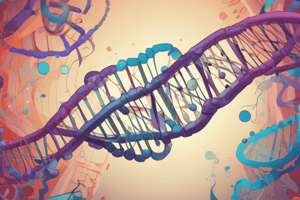Podcast
Questions and Answers
The Watson-Crick DNA Model describes DNA as a single strand.
The Watson-Crick DNA Model describes DNA as a single strand.
False (B)
Chargaff's Rules pertain to the pairing of nucleotides in DNA.
Chargaff's Rules pertain to the pairing of nucleotides in DNA.
True (A)
Rosalind Franklin's contributions primarily involved studies of RNA.
Rosalind Franklin's contributions primarily involved studies of RNA.
False (B)
The Hershey-Chase Blender Experiment confirmed that proteins were the genetic material.
The Hershey-Chase Blender Experiment confirmed that proteins were the genetic material.
Avery's DNA Experiment helped establish that DNA is the molecule of heredity.
Avery's DNA Experiment helped establish that DNA is the molecule of heredity.
Flashcards
Chargaff's Rules
Chargaff's Rules
This rule states that the amount of adenine (A) in DNA always equals the amount of thymine (T), and the amount of guanine (G) always equals the amount of cytosine (C).
Hershey-Chase Blender Experiment
Hershey-Chase Blender Experiment
The experiment that helped confirm DNA as the genetic material. It used radioactive isotopes to track the movement of DNA and protein during viral infection.
Rosalind Franklin's X-ray Diffraction
Rosalind Franklin's X-ray Diffraction
An image of DNA taken using X-ray diffraction. It showed the double helix structure and the spacing between the strands.
Watson-Crick DNA Model
Watson-Crick DNA Model
Signup and view all the flashcards
Nucleotide Structure
Nucleotide Structure
Signup and view all the flashcards
Study Notes
DNA Structure
- Gregor Mendel established the basic principles of heredity
- Avery's experiment aimed to identify the molecule responsible for transferring genetic information through transformation in heat-killed bacteria.
- Chargaff's rules state that each species has a unique percentage of each nucleotide type (A, T, G, C), and within a species, A=T and G=C.
- Hershey-Chase experiment used bacteriophages (viruses that infect bacteria) to determine if DNA or protein was the genetic material.
- Rosalind Franklin used X-ray crystallography to study DNA structure, including Photo 51.
- Watson and Crick's model described DNA's structure as a double helix.
- The helix turns clockwise.
- The backbones are in opposing directions.
- Nitrogenous bases are flat structures inside the helix.
- Bases are 3.4 angstroms apart.
- Adenine pairs with thymine using 2 hydrogen bonds, and guanine pairs with cytosine using 3 hydrogen bonds.
- There are 10 bases every 360° turn.
- There are 34 angstrom units in every complete turn.
- The double-helix diameter is 20 angstroms.
- DNA follows a semiconservative mode of replication.
Studying That Suits You
Use AI to generate personalized quizzes and flashcards to suit your learning preferences.




